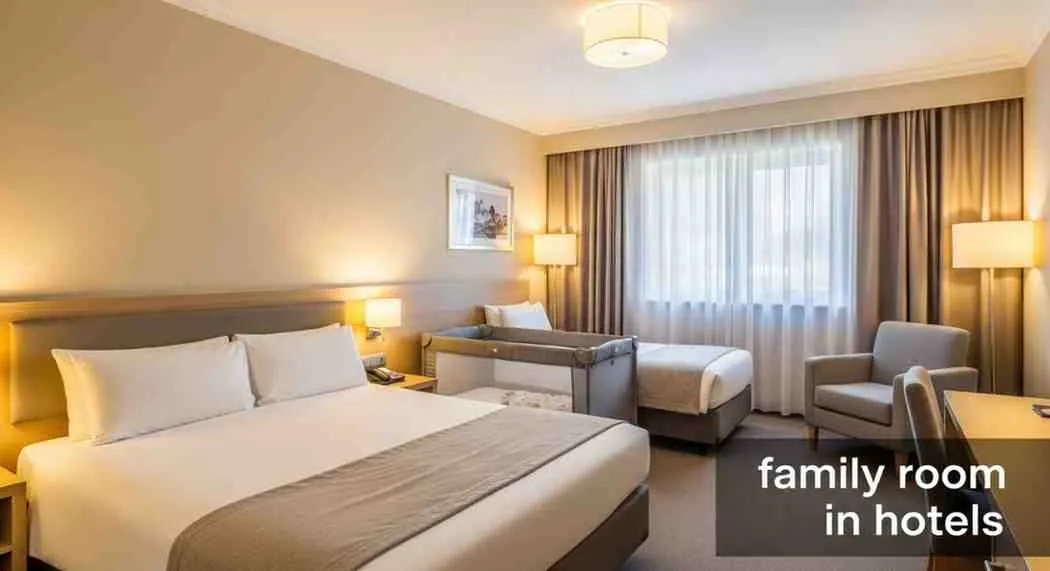Introduction
Picture this: You’ve just arrived at your hotel after a long journey with your toddler, only to be told that your standard double room isn’t suitable for three people. The confusion, frustration, and scramble to find alternative accommodation can turn a family vacation into a stressful ordeal before it even begins.
This scenario is more common than you might think. Many parents assume that any hotel room can accommodate their small family, only to discover that hotel policies, safety regulations, and room classifications work differently than expected. Understanding what a family room in hotels truly means—and how it differs from standard accommodations—can save you from unwelcome surprises and help you plan a comfortable, stress-free family trip.
In this comprehensive guide, you’ll learn everything you need to know about family rooms: their definitions across different countries, what they typically include, how they compare to standard rooms, and the crucial questions you should ask before booking. Whether you’re planning a weekend getaway in the UK or an international family vacation, this article will equip you with the knowledge to make informed decisions and ensure everyone in your family enjoys a comfortable stay.

What Is a Family Room in Hotels?
Defining the Family Room
A family room in hotels is a specially designated accommodation designed to comfortably sleep more than two people, typically including both adults and children. Unlike standard double or twin rooms that are optimized for couples or two adult travelers, family rooms are specifically configured with the needs of parents and children in mind.
The family room meaning in hotels varies slightly by establishment and region, but generally includes:
- Multiple sleeping arrangements: A combination of double beds, single beds, sofa beds, or bunk beds
- Additional space: More square footage than standard rooms to accommodate extra furniture and movement
- Child-friendly features: Safety considerations like socket covers, rounded furniture edges, and sometimes toys or entertainment options
- Flexible bed configurations: Options that can be adjusted based on family composition
What Does a Family Room Typically Include?
Most family rooms offer a standard set of amenities designed to meet the needs of traveling families:
Sleeping Arrangements:
- One double bed or two single beds for adults
- Additional sleeping options such as single beds, bunk beds, sofa beds, or pull-out beds for children
- In some cases, space for a travel cot (crib) upon request
Bathroom Facilities:
- Standard bathroom with shower or bathtub (family rooms rarely have two bathrooms unless they’re suites)
- Some hotels provide child-friendly amenities like step stools, bath toys, or baby bathtubs
Living Space:
- Seating area separate from the sleeping area
- Table and chairs for meals or activities
- Additional storage for luggage and children’s belongings
Entertainment & Comfort:
- Television with child-friendly channels
- Tea and coffee making facilities
- Mini-refrigerator (in some properties)
- Air conditioning or climate control
Regional Variations in Family Room Definitions
The concept of a family room isn’t universal, and understanding regional differences is crucial when booking accommodations abroad.
United Kingdom: UK hotels typically define a family room as accommodation suitable for two adults and one or two children. Family room UK hotels often feature one double bed and one or two single beds, or a double bed with a pull-out sofa bed. British hotel standards tend to be conservative regarding maximum occupancy, with fire safety regulations strictly enforced.
United States: American hotels often use terms like “family suite” or “connecting rooms” rather than simply “family room.” US properties frequently offer more spacious accommodations, and it’s common to find rooms with two queen or double beds that can accommodate families without specifically being labeled as family rooms.
Europe: Continental European hotels vary widely in their definitions. Mediterranean countries tend to be more flexible about children sharing rooms with parents, while Northern European establishments often have strict occupancy policies similar to the UK.
Asia and Middle East: Many hotels in these regions are particularly family-oriented, with family rooms often including separate sleeping areas, multiple bathrooms, or suite-style configurations. Some properties offer connecting rooms as standard family accommodations.
Family Room vs Standard Room: Understanding the Differences
Space and Layout
Standard Room:
- Typically 20-30 square meters (215-320 square feet)
- Designed for one or two guests
- Minimal living space beyond the bed area
- Standard hotel room layout focuses on efficiency
Family Room:
- Usually 30-50 square meters (320-540 square feet) or larger
- Designed for three to five guests
- Distinct sleeping and living areas
- More storage and movement space
Bed Arrangements and Sleeping Options
Understanding hotel bed arrangements is essential when booking for your family:
Standard Double Room:
- One double bed (typically 135cm wide in the UK, queen or king-size in the US)
- Designed for two adults
- Limited space for additional sleeping arrangements
Standard Twin Room:
- Two single beds
- May be pushed together or separate
- Generally not intended for more than two guests
Family Room Configurations:
- Double bed plus single bed(s)
- Double bed plus sofa bed
- Two double beds
- Double bed plus bunk beds
- Triple room (three separate beds)
Occupancy Policies and Child Accommodation
This is where confusion often arises. Hotels have specific policies about:
Age Definitions:
- Infant: Usually under 2 years
- Child: Typically 2-12 years (varies by hotel)
- Adult: Usually 12-18 years and older (varies)
Occupancy Rules: Many parents wonder: “Is a standard hotel room suitable for 2 adults and 1 child?”
The answer depends on several factors:
- The child’s age and size
- Hotel safety regulations and fire codes
- Local laws regarding maximum room occupancy
- Hotel chain policies
- Whether additional bedding is available
Important: Even if your child is small and can share your bed, some hotels may not permit it due to maximum occupancy restrictions based on fire safety regulations. Always declare all guests, including infants, when booking.
Pricing Considerations
Family rooms typically cost more than standard rooms, but the pricing structure varies:
- Flat rate pricing: One price regardless of occupancy (less common)
- Per-person pricing: Base rate plus additional charges per extra guest
- Child pricing tiers: Different rates based on child’s age
- Free child policies: Many hotels allow children under a certain age (often 12) to stay free when sharing existing beds
The cost difference between a standard room and a family room might range from 20% to 100% more, depending on the property and location.
Hotel Etiquette When Traveling with Children
Understanding hotel etiquette with children helps ensure a smooth stay for your family and consideration for other guests.
What Hotels Expect from Families
During Booking:
- Declare all guests, including infants
- Specify children’s ages
- Request necessary equipment (travel cots, high chairs) in advance
- Clarify bed arrangements
During Your Stay:
- Supervise children in common areas, pools, and playrooms
- Keep noise levels considerate, especially during quiet hours
- Report any damages immediately
- Respect hotel property and furnishings
Safety Responsibilities:
- Never leave young children unattended in rooms
- Use safety features provided (window locks, electrical socket covers)
- Keep balcony doors secure if applicable
- Store medications and hazardous items out of children’s reach
Hotel Room Policies for Children You Should Know
Maximum Occupancy: Hotel rooms have legal maximum occupancy limits based on:
- Fire safety codes
- Square footage
- Number and type of beds
- Local regulations
Exceeding these limits can result in:
- Refused check-in
- Additional charges
- Being asked to book an additional room
- Liability issues in case of emergency
Bed Sharing Policies: Some hotels explicitly prohibit bed sharing with children beyond infancy, while others allow it. This varies by:
- Hotel chain policy
- Country regulations
- Insurance requirements
- Room type
Age Restrictions: Certain room types or hotel facilities may have age restrictions:
- Spa areas often restrict children under 16
- Some boutique hotels don’t accommodate children under 12
- Club floors or executive lounges may have minimum age requirements
Travel Cot and Extra Bed Policies
One of the most common questions parents ask is: “Do hotels allow travel cots in regular rooms?”
Travel Cot Availability: Most hotels provide travel cots (portable cribs) upon request, but:
- Availability may be limited—book early
- Some hotels charge a small fee (£10-30 per stay)
- Others provide them free of charge
- They must fit safely within the room without blocking exits
- Not all standard rooms have sufficient space
Extra Bed Options: Hotels may offer:
- Rollaway beds (cots)
- Sofa beds
- Z-beds (folding beds)
- Additional charges usually apply
- Space and safety considerations determine availability
Important Tip: Always request these items at booking, not upon arrival, to ensure availability and proper room assignment.
Bed Arrangements & Sleeping Options: What Parents Need to Know
Understanding Different Bed Types
Double Bed:
- UK: 135cm wide (4’6″)
- US/International: 140-160cm (full or queen size)
- Suitable for: Two adults or one adult and one small child
Twin Beds:
- Two separate single beds (usually 90-100cm wide)
- Can sometimes be pushed together
- Suitable for: Two adults who prefer separate beds, or an adult and older child
King/Super King Bed:
- UK King: 150cm wide
- UK Super King: 180cm wide
- US King: 193cm wide
- Suitable for: Two adults with comfortable space, possibly with infant
Sofa Beds:
- Convert from seating to sleeping surface
- Quality varies significantly
- Usually suitable for children or teens
- Can be uncomfortable for adults for extended stays
Bunk Beds:
- Space-efficient for children
- Age restrictions often apply (usually 6+ for top bunk)
- Safety rails essential
Best Hotel Room Setup for Parents with Toddlers
When booking a hotel room for 2 adults and 1 child who is a toddler, consider:
Ideal Configuration:
- Double bed plus travel cot: Most practical for children under 2
- Double bed plus single bed: Good for toddlers who’ve outgrown cribs
- Family room with separate sleeping area: Allows parents privacy after child’s bedtime
Space Considerations:
- Ensure room for the travel cot without blocking access to bathroom or exit
- Look for rooms with space for spreading out toys and activities
- Consider ground floor rooms for easy stroller access
Safety Features to Request:
- Socket covers (outlet covers)
- Window locks or restrictors
- Bath mat to prevent slipping
- Furniture without sharp edges
Alternative Sleeping Arrangements
Connecting Rooms:
- Two separate rooms with internal connecting door
- Provides privacy while keeping family close
- Usually more expensive than a single family room
- Gives older children their own space
Suites:
- Separate bedroom and living area
- Often includes kitchenette
- More expensive but offers better space for families
- Allows parents space after children sleep
Adjoining Rooms:
- Two rooms next to each other (without connecting door)
- Less expensive than connecting rooms
- Less convenient but maintains proximity
Booking a Family Room: Critical Questions Parents Should Ask
Before You Book
Essential Questions:
- “What does a family room in hotels include in your property?”
- Clarify exact bed configuration
- Ask about room size
- Confirm amenities included
- “What is your policy for children under [age]?”
- Determine if they count toward occupancy limits
- Ask about charges
- Understand age definitions used
- “Do hotels provide extra beds for kids?”
- Availability of rollaway beds
- Associated costs
- Advance booking requirements
- “Are travel cots allowed in hotel rooms?”
- Complimentary or charged
- Advance reservation necessary
- Space limitations in chosen room type
- “Will a hotel refuse check-in with a child in a normal room?”
- Clarify occupancy policies
- Understand when family room is mandatory
- Know alternative options if refused
- “Can children stay in a standard double room?”
- Age restrictions
- Safety regulations
- Hotel-specific policies
Questions About Amenities
Child-Friendly Features:
- Is there a refrigerator for storing milk or food?
- Are baby-changing facilities available?
- Do you provide children’s toiletries?
- Are there child-safe cups, plates, or utensils available?
- Is there a children’s menu in the restaurant?
Safety Considerations:
- Are rooms childproofed?
- What floor is the family room on? (Ground floor preferred for toddlers)
- Are there balconies? Are they secure?
- Is the room near elevators or stairs? (Safety and noise considerations)
Entertainment & Convenience:
- Do you have a children’s play area?
- Are there family-friendly activities?
- What children’s TV channels are available?
- Is there a swimming pool? What are the age restrictions and hours?
How to Book a Hotel Room for a Family of Three
Step-by-Step Process:
- Research Properties:
- Search specifically for “family-friendly hotels” or “family room UK hotels”
- Read reviews from other families
- Check hotel websites for family-specific information
- Compare Options:
- Family room vs standard room with extra bed
- Connecting rooms vs suite
- Cost-benefit analysis
- Book Directly or Through Aggregators:
- Booking directly often provides more flexibility
- Call the hotel directly to clarify policies
- Use online booking for convenience but verify details
- Specify Requirements:
- Select “3 guests” including children
- Enter children’s ages accurately
- Add special requests in booking notes
- Confirm Details:
- Request written confirmation of room type
- Verify travel cot or extra bed inclusion
- Get cancellation policy in writing
- Follow Up Before Arrival:
- Reconfirm special requests 48 hours before check-in
- Verify early check-in if arriving with tired children
- Confirm parking or accessibility needs
Red Flags to Watch For
Warning Signs:
- Hotel refuses to clarify occupancy policies
- No specific family room category available
- Reviews mention issues with families or children
- Vague responses about extra beds or travel cots
- “Adults only” or “couples retreat” language in marketing
Regional Differences: Family Rooms in UK Hotels
What Do UK Hotels Consider a “Family Room”?
UK-Specific Standards:
British hotels have relatively standardized definitions of family rooms, largely influenced by:
- Fire safety regulations
- Historical building constraints (many UK hotels are in older buildings)
- AA (Automobile Association) and VisitBritain rating standards
- Consumer protection expectations
Typical UK Family Room:
- Accommodates 2 adults + 1-2 children
- Usually features one double bed and one or two single beds
- Total occupancy rarely exceeds 4 people
- More conservative space standards than US equivalents
Common Configurations:
- Standard Family Room: Double bed + single bed (sleeps 3)
- Larger Family Room: Double bed + 2 single beds (sleeps 4)
- Family Suite: Separate bedroom with double bed, living area with sofa bed or singles (sleeps 4-5)

UK Hotel Chains and Their Family Room Policies
Budget Chains (Premier Inn, Travelodge):
- Standardized family rooms across properties
- Usually 2 adults + 2 children under 16
- Children often stay free
- Travel cots provided free but must be booked in advance
- Clear policies published online
Mid-Range Chains (Holiday Inn, Novotel):
- More varied family room types
- Often include sofa beds
- Children’s age policies vary (typically free for under 12-18)
- Additional amenities like kids’ menus and play areas
- More flexible policies
Boutique and Independent Hotels:
- Policies vary significantly
- Some don’t accommodate young children at all
- Others offer bespoke family-friendly services
- Always call ahead to verify
Country House Hotels and B&Bs:
- Often in historic buildings with space constraints
- May have interconnecting rooms rather than large family rooms
- Policies highly variable
- Usually very welcoming to families but with practical limitations
Do UK Hotels Allow Children in Double Rooms?
This is one of the most frequently asked questions: “Do UK hotels allow children in double rooms?”
The Complex Answer:
UK hotels have varying policies based on:
Fire Safety Regulations:
- Maximum occupancy limits legally enforced
- Based on room size and exit access
- Strictly monitored by fire safety officers
- Violations can result in hotel fines and license issues
Age-Based Policies:
- Infants (under 2): Usually permitted in double room with travel cot
- Toddlers (2-5): Policies vary; many hotels say no unless family room booked
- Children (6-12): Almost always require family room or separate bed
- Teens (13+): Typically count as adults for occupancy purposes
Hotel-Specific Rules:
- Some budget hotels more flexible
- Luxury hotels often stricter
- Chain hotels have standardized policies
- Independent hotels decide case-by-case
Important: Never assume a double room can accommodate three people in the UK without explicitly confirming. Many hotels will refuse check-in if you arrive with an undeclared child, even if the child is young.
Real-Life UK Hotel Scenarios
Case Study 1: The Premier Inn Family Sarah and Mark booked a Premier Inn family room for themselves and their 4-year-old daughter. The room included one double bed and one single bed, costing approximately £89 per night. Their daughter could have stayed free in a travel cot, but they preferred the single bed for her comfort. The standardized layout meant they knew exactly what to expect, and the early check-in option was perfect after their long drive from London to Edinburgh.
Case Study 2: The Boutique Hotel Surprise Emma booked what she thought was a family-friendly boutique hotel in Bath for her family of three (two adults, one 3-year-old). Upon arrival, she was told that their “superior double room” couldn’t accommodate three guests due to fire regulations, despite her child being small. The hotel offered to upgrade them to a family suite at an additional £60 per night. Emma learned the importance of specifying all guests at booking and confirming policies in advance.
Case Study 3: The Travel Cot Request James and Lisa requested a travel cot when booking their Cotswolds hotel room. Despite confirming via email, no cot was available upon arrival as they’d run out. The hotel apologized and provided extra pillows to create a safe sleeping space on the floor for their 18-month-old, but the situation caused stress on their first night. This highlights the importance of reconfirming special requests 24-48 hours before arrival.

Pros and Cons: Family Room vs Standard Room
Advantages of Family Rooms
Space & Comfort: ✓ More square footage for movement and belongings ✓ Separate areas for sleeping and activities ✓ Proper beds for all family members ✓ Space for travel cot without crowding
Convenience: ✓ Everyone stays together ✓ Easier to supervise young children ✓ One room to organize and clean ✓ Often includes family-specific amenities
Cost-Effective: ✓ Usually cheaper than booking two standard rooms ✓ Many hotels offer free child occupancy ✓ Single booking simplifies arrangements
Safety: ✓ Designed with families in mind ✓ Often includes childproofing features ✓ Parents can monitor children easily ✓ Meets occupancy regulations
Disadvantages of Family Rooms
Cost: ✗ More expensive than standard double rooms ✗ Premium rates during school holidays ✗ Sometimes charges per child even at reduced rates
Availability: ✗ Limited inventory compared to standard rooms ✗ Book up quickly during peak seasons ✗ Not available in all properties ✗ May require booking well in advance
Quality Variation: ✗ Sofa beds can be uncomfortable ✗ Extra beds sometimes of poor quality ✗ Room configuration may not suit your family ✗ “Family room” definition varies by property
Location Within Hotel: ✗ May be on less desirable floors ✗ Sometimes near elevators (noise) ✗ Might not have best views ✗ Limited upgrade options
Advantages of Standard Rooms (with Extra Bed/Cot)
Cost Savings: ✓ Lower base room rate ✓ Extra bed charge usually minimal ✓ Better value for short stays
Flexibility: ✓ More rooms available ✓ Easier to change dates ✓ Better availability at peak times
Quality: ✓ Standard rooms often recently renovated ✓ Consistent expectations ✓ Better locations sometimes
Disadvantages of Standard Rooms for Families
Space Constraints: ✗ Cramped with extra bed or cot ✗ Limited movement space ✗ Storage challenges ✗ May not meet fire regulations for your occupancy
Policy Issues: ✗ May violate hotel occupancy rules ✗ Risk of refused check-in ✗ Extra bed not always available ✗ Uncomfortable sleeping arrangements
Suitability: ✗ Not designed for families ✗ Lacks child-friendly features ✗ Bathroom too small for family needs ✗ Insufficient power outlets and amenities
Frequently Asked Questions (FAQs)
What is a family room in hotels?
A family room is a hotel accommodation specifically designed to comfortably sleep more than two people, typically including both adults and children. It features multiple bed configurations (such as a double bed plus single beds or sofa beds), extra space compared to standard rooms, and sometimes child-friendly amenities. The exact definition varies by hotel and country, but family rooms generally accommodate 3-5 guests.
Can children stay in a standard double room?
This depends on the child’s age, hotel policies, and local regulations. Many hotels allow infants (under 2) to stay in a standard double room using a travel cot, but toddlers and older children often require a family room or additional bed due to fire safety regulations and maximum occupancy limits. Always declare all guests when booking and confirm the hotel’s specific policy to avoid being refused check-in.
Do hotels provide extra beds for kids?
Most hotels can provide extra beds (rollaway beds or cots) for children, but this depends on several factors: room size, availability, advance booking, and potential additional charges. Some hotels offer them free of charge, while others charge £10-50 per stay. Importantly, not all standard rooms have sufficient space to safely accommodate extra beds while maintaining fire safety compliance. Always request extra beds at the time of booking rather than upon arrival.
Are travel cots allowed in hotel rooms?
Yes, most hotels allow and provide travel cots (portable cribs) for infants and young toddlers, typically for children under 2-3 years old. Many offer them free of charge, though some impose small fees. However, availability can be limited, so you should always request one at the time of booking. The room must have adequate space to safely accommodate the cot without blocking exits or creating hazards. Some hotels have weight or size limits for travel cots.
What do UK hotels consider a “family room”?
UK hotels typically define a family room as accommodation suitable for 2 adults and 1-2 children (usually under 16). Standard configurations include one double bed and one or two single beds, with total occupancy rarely exceeding 4 people. UK family rooms are often smaller than American equivalents due to building constraints and fire safety regulations. Major chains like Premier Inn and Travelodge have standardized family room policies, often allowing children to stay free with free travel cots available upon advance request.
Will a hotel refuse check-in with a child in a normal room?
Yes, hotels can and do refuse check-in if you haven’t declared all guests or if the room type violates occupancy limits. This most commonly occurs when families book standard double rooms for 3 people without confirming the hotel’s policy. Fire safety regulations strictly limit maximum room occupancy, and hotels face legal liabilities for violations. Even if your child is small, undeclared guests or exceeding stated occupancy can result in refused check-in, requirement to book an additional room, or extra charges.
Is a standard hotel room suitable for 2 adults and 1 child?
It depends on several factors: the child’s age, the hotel’s specific policies, local fire safety regulations, and whether the hotel can provide suitable sleeping arrangements (like a travel cot or extra bed). For infants under 2, many hotels permit them in standard rooms with a travel cot. For toddlers and older children, hotels increasingly require families to book designated family rooms due to maximum occupancy rules. Always check with the specific property before assuming a standard room is acceptable for three people.
Do hotels allow travel cots in regular rooms?
Most hotels permit travel cots in regular rooms for infants and very young children, provided there’s adequate space without compromising safety or blocking exits. However, this doesn’t automatically mean a standard room is approved for three occupants—some hotels distinguish between allowing a travel cot and officially permitting three guests in the room. Always confirm both the availability of a travel cot AND the hotel’s occupancy policy for your specific room type when booking.
How to book a hotel room for a family of three?
When booking for a family of three, follow these steps: (1) Search specifically for “family rooms” or indicate 3 guests in your search parameters, (2) Always declare all guests including children during booking, (3) Enter your child’s age accurately as this affects pricing and room eligibility, (4) Request any special equipment (travel cot, extra bed) during booking, (5) Confirm bed configuration suits your needs, (6) Read the hotel’s cancellation and occupancy policies carefully, (7) Contact the hotel directly if you have questions about suitability, and (8) Reconfirm your requirements 24-48 hours before arrival.
What’s the difference between a family room and a suite?
A family room is a single room with multiple bed configurations designed for family occupancy, typically 30-50 square meters with sleeping and limited living space combined. A suite features separate rooms or clearly divided spaces—usually a bedroom and living area—offering more privacy and often including additional amenities like a kitchenette or multiple bathrooms. Suites are significantly more expensive but provide better space separation, allowing parents privacy after children’s bedtime. Family rooms are more economical for straightforward accommodation needs, while suites offer premium space and comfort.
Best hotel room setup for parents with toddlers?
The optimal setup for parents with toddlers includes: (1) A double bed for parents plus either a single bed or travel cot (depending on toddler’s age), (2) Ground floor location for easier stroller access and reduced noise concerns, (3) Room near but not directly adjacent to elevators (balancing convenience and noise), (4) Sufficient space for unpacking and spreading toys, (5) Childproofed features like socket covers and window locks, (6) Bathroom with bathtub rather than shower-only, (7) Small refrigerator for storing milk, snacks, and medications, and (8) Blackout curtains to help maintain sleep routines.

Conclusion
Choosing the right accommodation for your family doesn’t have to be complicated, but it does require understanding what a family room in hotels truly means and how different properties define this term. As we’ve explored throughout this guide, family rooms are purpose-built accommodations designed to comfortably and safely house parents and children, offering appropriate bed configurations, adequate space, and child-friendly amenities.
Key Takeaways:
- Always declare all guests, including infants, when booking to avoid check-in complications
- Understand that “family room” definitions vary significantly by country, with UK hotels often having stricter occupancy policies than US properties
- Standard double rooms may not legally accommodate three people, even if one is a small child, due to fire safety regulations
- Request travel cots and extra beds at the time of booking rather than expecting availability upon arrival
- Ask specific questions about bed configurations, occupancy policies, and child-specific amenities before confirming your reservation
- Research hotel-specific and chain-wide policies through reviews and direct contact with properties
Whether you’re planning a weekend getaway with your toddler or an extended family vacation, taking the time to understand hotel room categories and policies ensures a comfortable, stress-free experience for everyone. The right family room provides not just beds and space, but peace of mind that your accommodation meets your family’s specific needs.
Ready to Plan Your Next Family Trip?
Now that you’re equipped with comprehensive knowledge about family rooms, you can confidently book your next family vacation knowing exactly what to expect and what to ask. Remember, the best family accommodation is one that suits your specific family composition, budget, and comfort preferences.
We’d Love to Hear From You:
Have you had experiences booking family rooms that you’d like to share? Questions about specific hotel chains or destinations? Leave a comment below to help other families planning their travels. For more practical travel guides and family vacation tips, subscribe to our newsletter or explore our related articles on family-friendly destinations and travel planning strategies.
Share this guide with other parents who might find it helpful—planning family trips is always easier when we share knowledge and experiences with each other.



